Are you looking for that ideal home, but want to know more about home loans first? Did you know that the price of luxury homes has decreased from 2018 to 2019?
In this article, come explore the answer to the question, what is a home loan? Read on to explore how they work, why they’re beneficial, and how to choose the best loan option for your needs.
Table of Contents
What Is a Home Loan?
A home loan definition is a contract between the lender and the borrower in order to buy a home. To buy a home, you’ll borrow a certain amount of money that you’ll need to pay back over time, plus interest. There are different set periods to choose from which include 15 or 30-year loans.
The Different Types of Home Loans
The different types of home loans are adjustable-rate and fixed-rate mortgages. If you have an adjustable-rate mortgage, this means the interest on your loan can vary over time.
Adjustable-Rate
This is a risk since your interest has the potential to skyrocket. Lenders will encourage this type of loan by offering a low-interest rate within the first year.
Fixed-Rate
This is the most popular type of loan for home loans. You’ll have a fixed period of time that you’ll need to pay the lender back. Your interest rate will stay the same over this time period.
If you choose a fixed-rate over adjustable-rate, the price can cost more due to interest. The faster you pay your loan off, the less you’ll pay over time.
USDA
USDA home loans are what’s given to rural homebuyers who qualify. They don’t require a down payment and are through the USDA loan program.
The amount you can borrow is set by your home’s debt-to-income ratio. They’re given to many low-income applicants. You’ll need a certain credit score to qualify. You can refer to this USDA loan eligibility map to validate if you are eligible for a USDA loan.
FHA
An FHA property loan stands for the Federal Housing Administration Loan. FHA’s use 2 mortgage premiums which are annual MIP and UFMIP.
UFMIP stands for Upfront Mortgage Insurance Premium, and MIP is Mortage Insurance Premium. You’ll pay the Upfront Mortgage Premium when you close on your home.
FHA’s are easier to qualify for than a conventional loan. You can have a lower down payment and credit score to qualify.
Conventional
If you decide to go with a conventional loan, this is from private lenders, and not the government. You as the borrower will pay for the insurance.
Many consider them more of a risk since they’re from private lenders. They do offer more flexibility than government loans.
VA Loans
This is a mortgage loan that’s from the Department of Veterans Affairs (VA). This is for you if you have served, or are currently serving in the United States military.
They have very appealing benefits such as not needing a down payment, prepaying your mortgage without a penalty, and competitive interest rates. You won’t have to worry about private mortgage insurance premiums.
To see if you qualify, you’ll want to take a look at the VA website or talk to your lender. If you qualify, you can get a certificate of eligibility to show you’re eligible.
Government vs Conventional Loans?
When you think of a government loan these include FHA and VA loans. If you decide to go with an FHA, you’ll be required to put 3.5% down, and pay mortgage insurance over time. A MIP is there in case you default on the payment of your loan.
Conventional loans mean your lender is at risk if you don’t pay for your loan. If you can’t afford it, the lender will try to pay off your home with a short sale process or foreclosure.
What Are the Different Benefits of a Conventional Loan?
The benefits of a conventional loan include quick loan processing, low-interest rates, and lower private mortgage insurance. If you decide to go with a conventional loan, try to go for a 15-year fixed-rate mortgage so you can pay it off faster.
Before agreeing to a loan, ensure that you’ll have enough left over for your savings and for other bills. If you decide to go with a 30-year mortgage, you’ll wind up paying thousands of dollars more over time.
Choosing a Lender
After exploring the different types of home loans, you’ll need to find a lender. You’ll want to first decide on how much house you can afford, and what you’re looking for in a home.
Consider how long you plan on staying in your home. If you don’t see yourself staying in it for long, that will affect whether you’ll want to go with a fixed-rate or adjustable-rate mortgage.
You’ll also want to consider interest rates at the time of your search, and loan types. Talk to your lender about your different options to determine what your best option is.
Talk to different lenders in your area, and see what their estimates are. Remember that choosing one lender over another can save you thousands of dollars.
Understand how much your loan will cost you over time. You’ll need to factor in MIP if you’re not putting 20% down.
You’ll also need to factor in MIP if you’re not going with a loan that allows you to skip paying for it. Think about taxes and home owner’s insurance as well.
Answering the Question To, What Is a Home Loan?
Now that you’ve explored the answer to the question, what is a home loan, you should have a better idea of what loan is correct for you. Would you like to learn more about home living from DIY to lifestyle? For everything from creating your custom kitchen on a budget, to keeping warm in the winter, check out our other articles today.
















